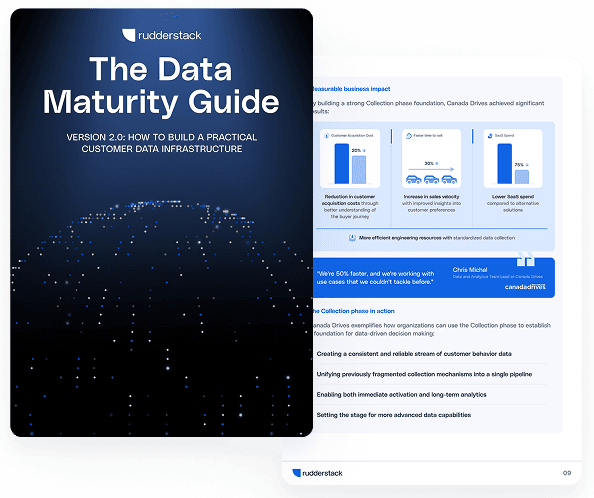Data warehouse automation: Tools and benefits

Data engineers are often bogged down by repetitive, manual tasks—writing ETL code, updating schemas, fixing broken workflows. These bottlenecks slow teams down and delay the insights business leaders rely on.
Data warehouse automation flips that dynamic. By automating ingestion, transformation, modeling, and documentation, it frees teams from reactive maintenance and accelerates time to insight. The result is cleaner data, faster delivery, and more time for strategic work.
In this article, we'll explore what data warehouse automation is, its key benefits, use cases, and the essential tools that can help you modernize your analytics pipeline.
Main takeaways:
- Data warehouse automation streamlines ETL, modeling, testing, and documentation through metadata-driven workflows, reducing manual coding and accelerating development cycles
- Automation tools improve data quality and consistency by enforcing standardized processes, automated validation, and synchronized documentation across your pipelines
- AI-powered and model-driven solutions enhance automation with intelligent recommendations, performance tuning, and real-time error detection
- Real-time and event-driven capabilities enable up-to-the-minute analytics by automating the ingestion and processing of streaming data
- Effective implementation of data warehouse automation improves governance with automated lineage tracking, access controls, and compliance-ready audit trails
What is data warehouse automation?
Data warehouse automation (DWA) is technology that streamlines the design, development, and management of data warehouses through automated processes rather than manual coding. It uses metadata-driven approaches to generate and maintain ETL pipelines, data models, and documentation automatically.
Modern data warehouse automation tools handle repetitive tasks like code generation, testing, and deployment while enforcing best practices and quality standards.
Why do we automate the data warehouse?
The case for automation is only getting stronger. Recent industry research shows that the global warehouse automation market—driven by investments in AI and robotics—is projected to grow from $26.5 billion in 2024 at nearly 16% compound annual growth rate (CAGR) through 2034. As more organizations prioritize speed, scalability, and reliability, automating the data warehouse is becoming a critical step toward modern analytics operations.
Here are the core benefits driving teams to adopt DWA.
Reduced manual coding
Data warehouse automation software eliminates repetitive coding tasks by generating transformation logic and pipeline code automatically. This frees engineers to focus on more complex challenges instead of writing boilerplate ETL scripts.
You'll spend less time debugging hand-coded solutions and more time delivering value from your data. The consistency of automated code also reduces errors that commonly occur in manual development.
Faster time to insight
With DWA tools, you can deploy new data models and sources in hours rather than weeks. Business users get access to analytics-ready data faster, enabling quicker decision-making.
This acceleration happens because automation handles the time-consuming tasks of schema creation, pipeline development, and testing simultaneously rather than sequentially. The result is dramatically shorter development cycles for your data projects.
Improved data quality and consistency
Automation enforces consistent standards across your data warehouse. Every transformation follows the same patterns, and validation checks run automatically to catch issues early.
- Standardized processes: Apply the same quality rules across all data pipelines
- Automated validation: Catch data quality issues before they reach analysts
- Consistent documentation: Keep technical documentation synchronized with actual implementations
Key processes that benefit from warehouse automation
Warehouse automation tools transform how you build and maintain data infrastructure by standardizing and accelerating core processes.
| Process | Manual approach | Automated approach |
|---|---|---|
| Data modeling | Hand-coded schemas | Auto-generated from metadata |
| ETL development | Custom scripts | Template-based generation |
| Testing | Manual QA | Automated validation |
| Documentation | Often outdated | Auto-generated and current |
Let’s take a closer look at how these areas change with automation:
1. Data modeling
Manually coding schemas and updating them as business needs evolve is tedious and error-prone. Automation tools streamline this by generating models directly from metadata. They support industry-standard designs like star schema or data vault and keep your models aligned with business definitions even as requirements change.
2. ETL development
Building custom scripts for every integration can consume weeks of engineering time. Automation replaces that with template-driven ETL generation. Tools provide drag-and-drop or declarative workflows, pre-built connectors, and built-in change data capture, so pipelines can be deployed and updated with minimal manual effort.
3. Testing and validation
Without automation, quality checks are often inconsistent or skipped altogether. With warehouse automation, validation is built in. The system continuously checks for format issues, incomplete data, failed transformations, and anomalies, so errors get caught early, before they reach your reports or dashboards.
4. Documentation
Keeping technical documentation current is often the first task to fall through the cracks. Automation tools generate documentation alongside every model, transformation, and deployment, so your team always has a reliable reference point for onboarding, debugging, and audits.
By automating these processes, your team can shift from firefighting to focusing on higher-impact work, building a more agile, trustworthy, and scalable data environment.
How to assess your readiness for data warehouse automation
Before implementing warehouse automation tools, evaluate your current environment and team capabilities to ensure a smooth transition.
1. Conduct an infrastructure and tools audit
Review your existing data infrastructure to determine compatibility with automation solutions. Most data warehouse automation software works with major cloud warehouses like Snowflake, Google BigQuery, and Amazon Redshift, as well as traditional platforms such as Microsoft SQL Server, Oracle, and Teradata.
Pay particular attention to your warehouse's API capabilities, concurrency limits, and support for stored procedures, all of which impact automation efficiency.
Check if your current ETL tools and analytics technology can integrate with automated pipelines. Modern automation solutions offer APIs and connectors for seamless integration with your existing stack, including orchestration tools like Airflow and dbt, visualization platforms such as Tableau and Power BI, and version control systems like GitHub. Verify that your security configurations, including network policies and authentication mechanisms, will accommodate the automation tool's connection requirements without compromising your data protection standards.
2. Evaluate your team's skillset
Assess whether your team has the skills needed to implement and maintain automated systems. While automation reduces manual coding, it requires expertise in data modeling, metadata management, and the specific automation tools you choose.
Your team should include members familiar with dimensional modeling techniques, source system structures, and business logic implementation. Additionally, look for experience with metadata repositories, version control systems, and the ability to translate business requirements into technical specifications.
Consider whether your current staff can configure automation templates, troubleshoot integration issues, and optimize automated workflows, or if training or new hires will be necessary.
Tools for data warehouse automation
The market offers various data warehouse automation tools with different approaches and strengths. Understanding the options helps you select the right solution for your needs.
You should look for:
Model-driven solutions
Model-driven data warehouse automation software uses visual interfaces and metadata repositories to define and manage data models. These tools generate all the necessary code from your models, ensuring consistency between design and implementation.
They excel at maintaining complex data warehouses with multiple sources and frequent changes. The visual approach makes it easier for team members with different skill levels to collaborate on data projects.
AI-powered orchestration
Advanced data warehouse automation tools now incorporate AI to enhance capabilities beyond basic automation. These systems can detect data drift, optimize query performance, and suggest improvements to your data models.
AI-powered tools learn from your data patterns and usage to make intelligent recommendations. They can automatically adjust resource allocation, suggest indexing strategies, and identify potential data quality issues before they impact your analytics.
Accelerate warehouse automation with RudderStack
RudderStack enhances your automation stack with real-time streaming, schema validation, and 150+ integrations, so your data flows cleanly from source to warehouse. Request a demo
Real-time data automation strategies
Modern businesses need real-time data for analytics and operations. Data warehouse automation tools now support streaming data alongside traditional batch processing.
Stream processing approaches
Stream processing enables continuous data flow from sources to your warehouse. Automation tools handle the complexities of managing these real-time pipelines, including error handling, scaling, and monitoring.
With automated stream processing, you can analyze data as it's generated rather than waiting for batch windows. This enables immediate insights and faster response to business events.
Event-driven pipelines
Event-driven architectures use triggers to initiate automated workflows when specific events occur. This approach creates responsive, decoupled systems that process data efficiently.
RudderStack supports event-driven data collection and delivery, enabling you to automate the flow of customer data from digital touchpoints to your warehouse in real time. This keeps your analytics current without adding operational complexity.
Overcoming governance and quality challenges
Effective data warehouse automation tools enhance governance rather than compromising it. They build compliance and quality controls directly into automated processes.
Automated data lineage
Automation tools track data lineage automatically, documenting every transformation and movement of data. This visibility helps you understand where the data came from, how it was processed, and where it's being used.
Complete lineage information supports compliance requirements and makes it easier to assess the impact of potential changes. When issues arise, you can quickly trace them to their source.
Built-in compliance controls
Modern warehouse automation tools include features to enforce regulatory compliance automatically. They manage access controls, mask sensitive data, and maintain comprehensive audit logs.
- Access management: Automatically enforce role-based permissions
- Data masking: Protect sensitive information according to policy
- Audit trails: Track all data access and changes for compliance reporting
Steps to implementing an automated architecture
A thoughtful rollout is key to realizing the full benefits of data warehouse automation. Rushing implementation can lead to brittle systems and missed opportunities. Instead, follow these three strategic phases to ensure a smooth transition and long-term success:
1. Plan and design
Start by identifying high-impact, repetitive processes that are slowing down your data team—common examples include manual ETL development, schema maintenance, and ad hoc documentation. Define clear success metrics tied to business goals, such as reduced time-to-insight, fewer data quality incidents, or engineering hours saved.
During this phase, audit your current data sources, models, and transformation logic. This helps you surface inconsistencies and technical debt that automation can resolve. Align early with stakeholders to ensure the resulting pipelines meet both business and compliance requirements.
2. Configure and integrate
Begin with a contained, low-risk domain (like marketing analytics or support operations) to validate your automation workflows. Configure templates, naming conventions, lineage tracking, and validation rules to align with internal standards.
Use this phase to test integrations with existing tools—such as dbt, orchestration platforms, version control systems, and BI tools—and document configuration patterns for reuse. Developing a playbook during this stage ensures consistency as automation expands across your data domains.
3. Monitor and optimize
Once in production, continuously monitor your automated pipelines for latency, data accuracy, system performance, and job reliability. Leverage built-in dashboards and alerting features to track anomalies, schema drift, and failed runs.
Use these insights to refine transformation patterns, reduce pipeline bottlenecks, and proactively adjust to upstream changes. As your team gains confidence, expand automation to additional domains, processes, and real-time use cases—making automation a standard part of your data operations strategy, not a side project.
Maximizing business value and ROI
To get the most from data warehouse automation, focus on measurable outcomes and ongoing optimization, not just technical wins.
- Define impact-driven KPIs like engineering hours saved, report delivery speed, and reduction in data quality issues.
- Automate high-friction areas first, such as onboarding new sources or maintaining compliance dashboards.
- Evaluate the total cost of ownership, including maintenance, training, and opportunity cost, not just licensing fees.
- Tie results to business goals, like faster product launches or improved forecasting.
- Continuously refine your pipelines using performance metrics to improve efficiency over time.
Moving forward with a flexible infrastructure with RudderStack
Data warehouse automation gives you speed and consistency, but real value comes from pairing it with flexible, real-time infrastructure. RudderStack makes that possible. Our data cloud-native platform helps you collect, transform, and deliver customer event data from 150+ sources—without extra engineering lift.
With built-in privacy controls, real-time streaming, and automatic schema validation, RudderStack ensures your data stays clean, compliant, and analytics-ready. The result? Faster insights, tighter governance, and a pipeline that scales with you.
Request a demo to see how RudderStack elevates your automation strategy.
FAQs about data warehouse automation
What specific tasks do data warehouse automation tools handle?
Data warehouse automation tools handle ETL code generation, schema creation, documentation, testing, deployment, and monitoring tasks that would otherwise require manual effort from data engineers.
How does data warehouse automation improve data governance?
Data warehouse automation improves governance by enforcing consistent standards, automatically tracking lineage, implementing access controls, and maintaining comprehensive audit logs for all data processes.
What types of data warehouse automation software are available?
Available options include metadata-driven tools that generate code from models, template-based systems that standardize common patterns, and AI-enhanced platforms that optimize performance and suggest improvements automatically.
Published:
July 2, 2025

Event streaming: What it is, how it works, and why you should use it
Event streaming allows businesses to efficiently collect and process large amounts of data in real time. It is a technique that captures and processes data as it is generated, enabling businesses to analyze data in real time

RudderStack: The essential customer data infrastructure
Learn how RudderStack's customer data infrastructure helps teams collect, govern, transform, and deliver real-time customer data across their stack—without the complexity of legacy CDPs.

Scaling data products starts with fixing the foundation: Five lessons we’ve learned
Most teams don’t have a modeling problem—they have a foundation problem. This post shows how to standardize your pipeline, put one owner in charge, and use observability to scale data products.






